by California Casualty | Behind the Scenes, Calcas Connection |
“Learn, Adapt, Grow.”
Our Field Marketing managers are literally the “faces” of California Casualty, visiting schools, fire and police stations, hospitals and healthcare facilities, as well as attending group benefit fairs, orientations and charitable events. Year after year, they strive to improve on their skill sets to provide the best service for you and the groups to which you belong. Learn Adapt Grow
We believe strongly in investing time and effort to help them succeed. To facilitate this effort, our Field team attends a yearly Partner Relations Summer Meeting. The goal of the three-day gathering is to discuss best practices, share success stories, and learn new ideas. This year’s theme was “Learn, Adapt, Grow.”
Some of this year’s highlights included discussions about better time management, the importance of self-care, adapting to challenges in the insurance industry, and enhancing relationships with the groups/vocations that we serve. Our Field representatives came away with new valuable lessons on providing you with exceptional service.
Important breakout sessions included:
- Understanding insurance fraud and how California Casualty protects customers from being victims of fraudulent activities
- Products and services that differentiate California Casualty from other insurance companies
- A refresher of the many tools California Casualty provides for informing group members about their auto and home insurance benefits and how to market them
- The importance of helping individuals to strengthen our partnerships
- A wellness presentation on simple tactics to stay healthy and how to be the best for others
- A recognition ceremony and award presentation for the high achievers of our Partner Relations team
“I am amazed at how hard every one of our team works each day for our affinity groups and their members,” said Midwest Field Team Manager, Rebecca (Becky) Stumpf. “Sharing stories, having a better understanding of our products, and fulfilling our promises provides us better tools to serve and strengthen those partnerships.”
Amy Grosso, Assistant Vice President of Field Relations for the East, noted the value of the meeting to help build team unity and re-energize our Partner Relations team. “This is the one time, each year, that remote-based employees get together to build rapport, introduce new members, and recognize our annual award recipients. They leave this meeting with new ideas and energy that will enhance their relationships in the field and improve productivity,” she said.
Katelyn Hoffman, Field Marketing Manager for Missouri, said, “The amount of time and thought put into this meeting was amazing and truly appreciated. I am proud to be part of such an impressive organization – not only because the company is great, but I love our mission of helping those in public service create better lives for themselves and their families.”
California Field Marketing Manager Chris Renn and Washington Senior Field Marketing Manager Michelle Hawkins both agreed that the time spent at the meeting was not only valuable for them personally, but will enhance their efforts working with you. “I have a lot more tools to provide fresher and more specific information at the right time to better serve my groups,” said Chris.
Michelle added, “I always come back from the meeting with a huge to-do list. I am inspired by my peers to push myself a little more here and there to benefit our valued partners.”
You will soon be seeing our knowledgeable Field team members at your place of work or other work-related events. They will be invigorated to share the many ways California Casualty is looking out for you. They can also give you details on our many giving programs, like the $7,500 Garage Makeover for public safety, $2,500 Academic Award for educators, and the Music and Arts Grants for schools.
We appreciate all that you do, and our people are ready to serve you.
TAKEAWAY: California Casualty Field Marketing team members are in your community to meet you and show the benefits of our auto and home insurance through your affiliation. Learn more about our personalized service at www.calcas.com/why-california-casualty.

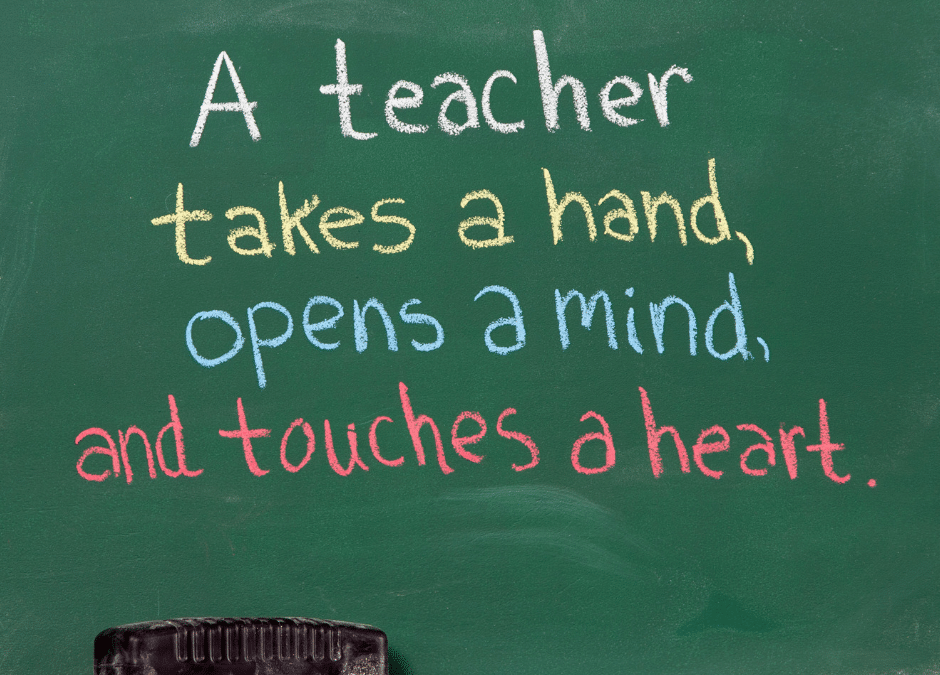
by California Casualty | Educators |
You’ve spent long hours preparing for your career in teaching, but researching, studying, student teaching, creating lesson plans, and interviewing can only prepare you for so much. Your biggest lessons will come from experience. We’ve gathered some tips to remember as you begin your teaching career.
Here are 10 things you need to know as a new teacher:
- Be organized, yet flexible, at school and at home. Situations arise that you have no control of, and that is okay. Learn not to stress when you are behind or have to modify your schedule.
- Get to know your students. You are around them more than their parents, and they look up to you as they would a parent. However, realize not everyone will like you, and that is okay.
- Build professional relationships within your school. Watch others teach, ask questions, and find a mentor. You aren’t alone in this.
- You’re the adult in the room. Carry out punishments and rewards firmly, and fairly. Earn their respect and trust, and then start building your friendships.
- Listen to advice and trust your gut. Nothing can prepare you for actually getting in front of a classroom and teaching, but you know what to do. Trust your instincts, and don’t be afraid to ask if you need help.
- Expect to make mistakes. Teachers with decades of experience are still making mistakes. Learn to cope with the fact that making a few mistakes is inevitable.
- Empathize with your students. Be patient with your students, not everyone learns at the same pace or has available resources at home.
- Never stop learning and bettering yourself. Go to conferences, stay on top of best practices, and implement new teaching strategies into your lesson plans.
- Don’t let work overshadow your personal life. Don’t burn yourself out, try and maintain work/life balance. Don’t spend too many hours at school or grading papers, it will affect you and your teaching.
- Always remember your motivation. Remember what made you get into teaching, and hang on to it when times get tough and you feel defeated.
Being a new teacher will come with its ups and downs, but knowing that you are making a difference with your students is what makes up for it. You are going to do great! 🙂
This article is furnished by California Casualty, providing auto and home insurance to educators, law enforcement officers, firefighters and nurses. Get a quote at 1.866.704.8614 or www.calcas.com.
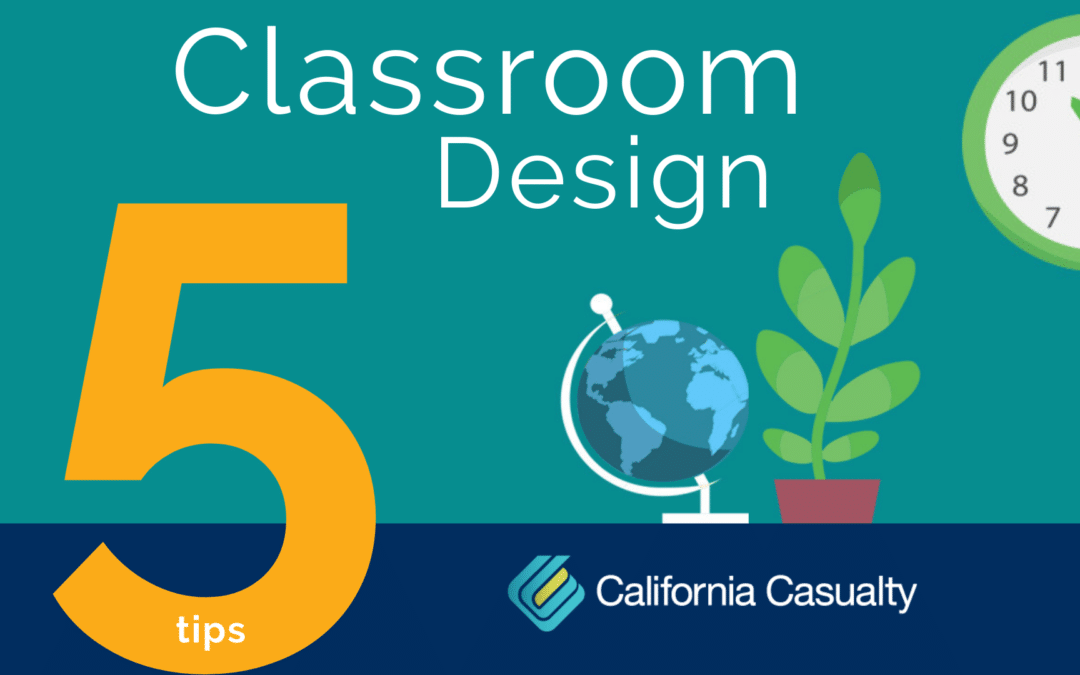
by California Casualty | Educators |
It’s August, which means it’s officially back to school season, and many teachers are working hard in their classroom to get it prepared for that first day!
An organized classroom is an integral part of the learning process. Did you know that the way you structure you classroom design can actually boost learning in students, reduce disruptive behavior, and keep them on task? Behavioral problems in children have been linked back to poor color planning and lighting alone! So, keep these 5 classroom design tips in mind when you organize your space this year:
1. Color
White walls are under-stimulating, while too much color causes over-stimulation. The key to “coloring your classroom” is to find balance and make it comfortable. When using color you want something that is conductive to learning, while positively promoting mental and physical well-being.
For Young Children: Use brighter, warm, colors to draw in their focus on whats going on in the classroom instead of outside, like: yellow, red and orange.
For Older Children: Use calming colors that allow the teenagers to focus on their work, and not their surroundings, like: blue, purple, green, and gray.
If you are able to paint your classroom avoid picking colors that are too bright. Instead pick a more muted shade that will not be distracting. And when you have chosen a color palette do not paint the entire room, instead paint a wall or two and leave the rest neutral. If you’re school does not allow you to paint you could always follow the color scheme you like with your decor. Find posters and create bulletin boards around the color theme you like, and buy furniture for your classroom (like chairs, rugs, storage bins, shelves, etc.) that complement that theme.
2. Light
Harsh lighting can cause headaches and disruptive behavior in students, so it is important to find the proper lighting for your classroom. Research shows that with the right lighting student’s test scores even increase! The key is to use as much natural light as you can, or lights that imitate natural light (aka lights with blue undertones). When students are taking tests, the natural feel helps them relax and focus. If you don’t have enough natural light or you prefer to keep the lights off you can fill up your classroom with lamps, hanging lights, or Christmas lights. Just try and avoid yellow undertones because those tend to make students more fatigued.
3. Digital Spaces
Students today are not just learning in the classroom, they are learning in the digital dimension. It is important for teachers to create digital experiences that connect students and provide-user paced, student-centered lessons as a way to add another dimension to the physical space. Providing resources to students digitally helps teachers build relationships with them. So, to help students feel safe in this space teachers must introduce it, establish rules and norms, and visit it frequently.
STEPS:
- Choose an online system that best suites you and your class
- Create an account and add your students
- Create activities and set aside a specific time for those activities
- Never stop exploring what’s new
Whether you have one online activity, or many, that you do with your students, you should have a spot in your classroom where online activity is represented. Consider a discussion board, or a table that you gather around to view. OR set aside time in the day/week that you do activities on a SMART board or computer together and create in-person activities that go along with them!
4. Layout
Classroom layout can result in a 45% increase in academic engagement. Desk arrangement all comes down to how much space you have, what you think would work best for your class, and how they learn. You could set your students in a:
- Standard spaced out arrangement
- Angled rows
- Modified U or Horseshoe
- Groups
- Combination
Or choose one layout and then mix it up every quarter!
Another option is flexible seating for students. Flexible seating is student-centered and ditches the idea of a regular desk. Instead it focuses on a variety of different seating options varying from stools, bean bags, rockers, stability balls, couches, padded storage bins, pillows, etc. Students love it because they are not just stuck in a regular desk. They will have more mobility and can be more comfortable. As long as your students are happy and it boosts learning, the possibilities are endless!
5. Walls
The walls in your classroom should be fun and conducive to learning! So when you are decorating them, ask yourself from the student’s perspective, “Is this overwhelming?” A great idea that you have in your head or saw on Pinterest may have too much print or be too harshly colored for your students depending on their age. You should keep at least 20-50% of your walls clear to prevention over stimulation. However that doesn’t mean you can’t have fun with it!
You can fill your walls with positive messages, student crafts, and learning materials, but it is also recommended to have at least one wall set aside for student engagement. Something the students can go to everyday and find resources, learn new words/facts, interact with each other, or turn in their work.
If you are having trouble finding ideas for your classroom walls we have created a list of Bulletin Board Ideas and more, click here.
So, what are waiting for?! Go get that organized classroom started! But first, be sure to download our 5 Classroom Design Tips below.
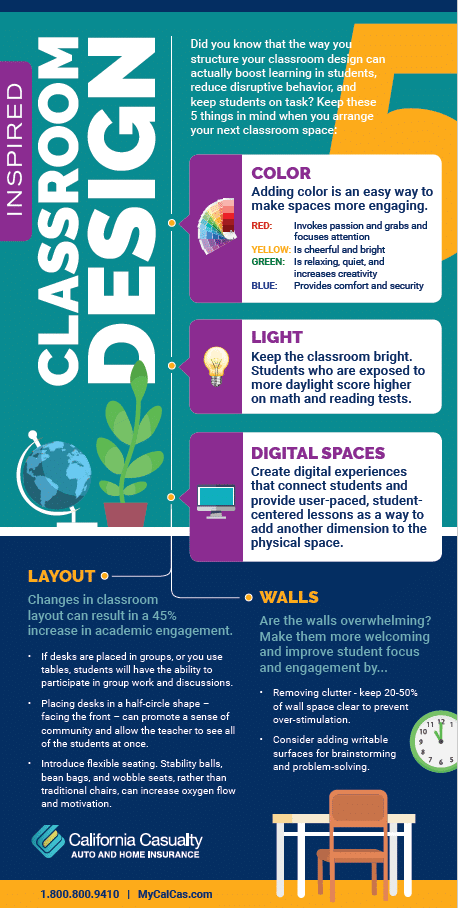
For more information visit:
https://bit.ly/2SZ5Fr2
https://bit.ly/2Kb4ZMC
https://bit.ly/2T31uuG
https://bit.ly/2OJ4rBM
https://bit.ly/2YEBRp3
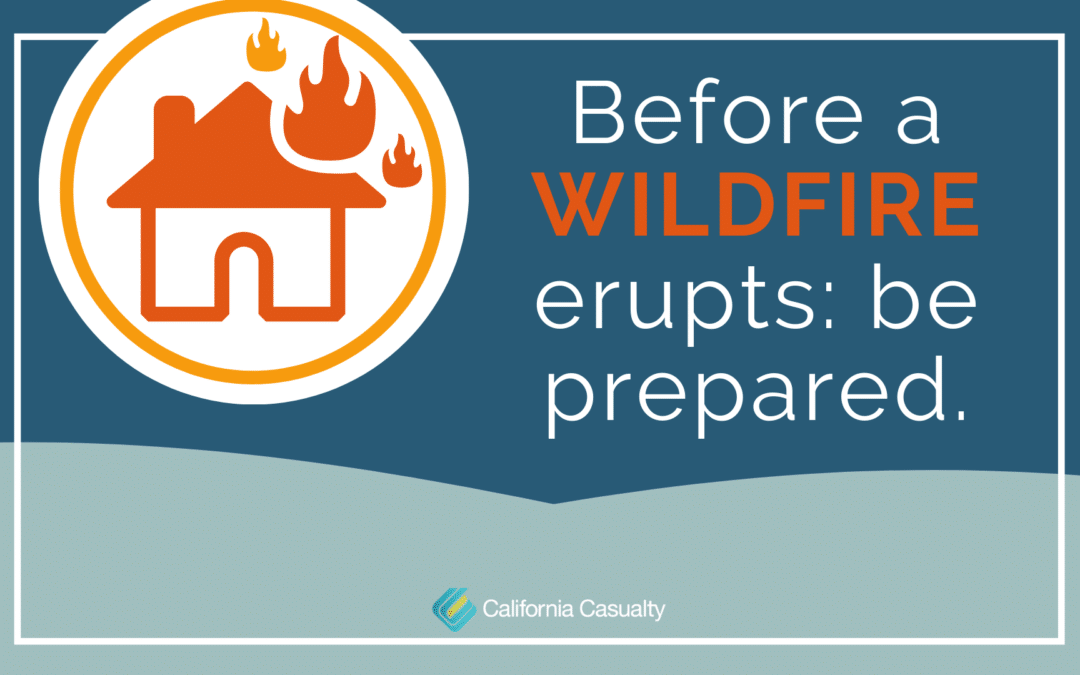
by California Casualty | Homeowners Insurance Info, Safety |
Wildfires seem to be burning faster and more intense than ever. The past few years have seen the largest and most destructive conflagrations in US history. Wildfire preparation tips are more important than ever.
Too many people have come back to find melted remnants of prized personal possessions; homes in ashes.
Here are five key wildfire preparation tips for your community or neighborhood:
- Create a home inventory. 60% of homeowners and renters have still not documented the things they own, which can cause post-fire/disaster headaches.
- Know where fire extinguishers are kept and teach everyone how to use them. Make them easily accessible in the event an of emergency.
- Have a family escape plan. Practice how you would exit your home from different rooms in the event of a fire and set a safe meeting point, away from the property, if you were to get separated.
- Prepare an emergency kit with important documents. Include copies of banking information, insurance policies, home mortgage and deeds, etc.
- Review and understand your insurance policy. Whether you are renting or owning, know what it pays and does not pay for. Get extra protection for collectibles and high-dollar possessions with a scheduled personal property endorsement.
While these are great wildfire preparation tips, there are several other things to keep in mind in you are effected :
- Contact your insurance company as soon as possible
- Secure the property from further damage
- Contact creditors, banks and appropriate agencies about credit cards, tax returns, Social Security cards or other papers that may have been scattered in the disaster
- Check your credit report to make sure nobody is using your personal information
- Be very wary of fly-by-night work crews and contractor fraud
Download and print your copy of these Wildfire Preparation Tips here.
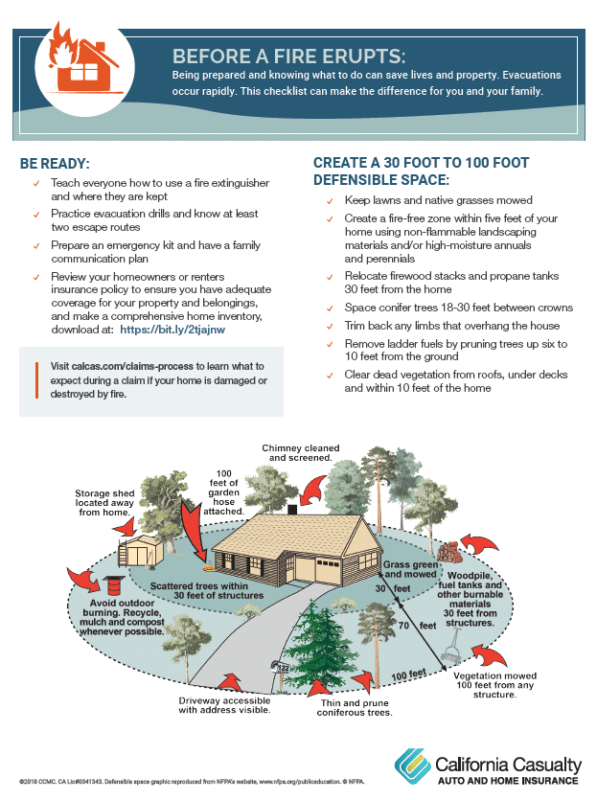
This article is furnished by California Casualty, providing auto and home insurance to educators, law enforcement officers, firefighters and nurses. Get a quote at 1.800.800.9410 or www.calcas.com.
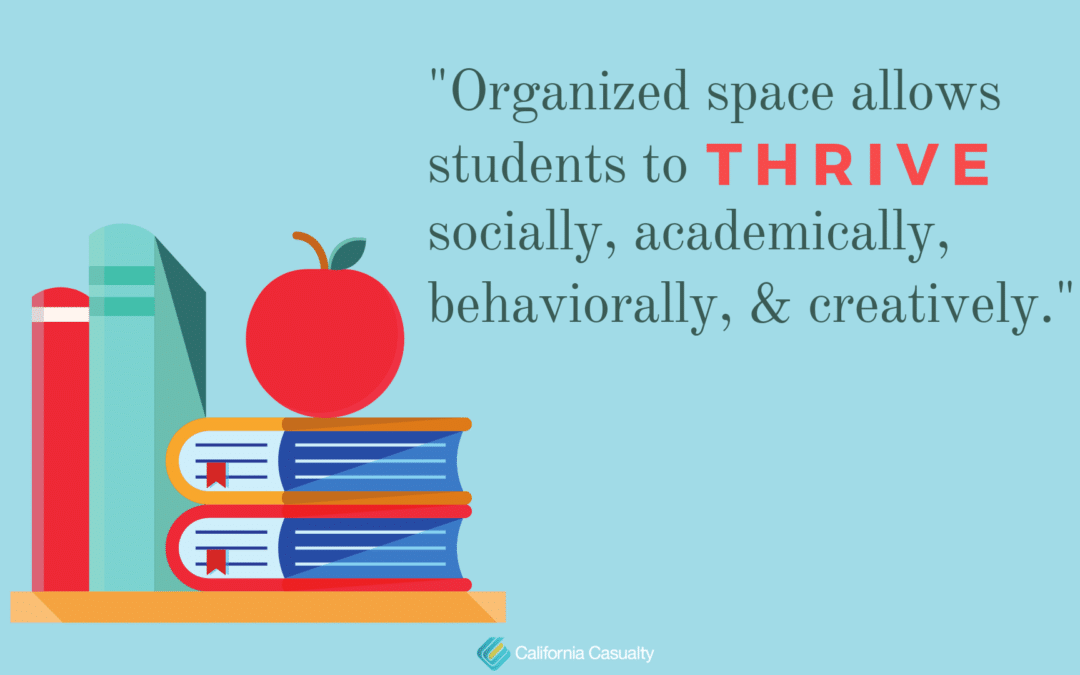
by California Casualty | Educators |
Our Education Blogger is a public school teacher with over a decade of experience. She’s an active NEA member and enjoys writing about her experiences in the classroom.
An organized classroom is an integral part of the learning process. Your classroom should be an environment where quality learning occurs. It should also be a safe, organized space that allows students to thrive socially, academically, behaviorally, and creatively.
How Does An Organized Classroom Benefit Students?
Your classroom organization reflects the structure and management of your classroom. The classroom is a constant reminder to students of classroom expectations and procedures: organized classroom = high teacher expectations. Students also thrive in a predictable environment where they feel safe.
“Everything Has a Home”
I once heard a colleague say: “Everything Has A Home.” I love this line (and I use it at home with my own children). All items, whether in the classroom or in your home, have a specific place where they belong. Having specific, labeled locations for supplies, materials, and books makes for swift access and less time wasted.
Classroom Materials and Supplies
Materials and supplies that are used frequently should be easy to access for the teacher and students. Use baskets, storage bins, milk crates, and plastic drawers to help organize supplies. Labels are a big help, too.
Desk Arrangement
Preferences for how to arrange student desks varies greatly from teacher to teacher. One thing to think about is how you instruct or how you want students to learn. If you like students to work in groups, set up tables or clusters of desks. If you prefer whole group discussion, a U-shape or circle works well. Students working on self-paced learning may need learning stations. Many teachers also arrange student desks so they can make eye contact with as many students as possible. Students should also be able to see the instructor and the white board/projector. Whatever your preference, make sure you can move easily throughout the classroom.
Student Materials and Supplies
“Train” your students to be organized. Ask students to have a folder or binder for your class. If you require students to keep handouts, syllabi, and other paper materials with them, ask them to label a folder in which to keep said items. In my elementary classroom, we have a folder for each subject, a homework folder, and a Friday folder.
Why Should I Organize My Own Classroom?
In addition to benefiting students, classroom organization is also helpful to the teacher. Having an organized classroom allows teachers to spend more time on the more “important” stuff, like planning meaningful lessons and building student relationships. Creating and maintaining an organized classroom also causes less teacher stress, frustration, and fatigue. It sounds cheesy, but having a tidy classroom makes you look good to administrators and parents; you look like you’ve “got it together.” A neat and orderly classroom shows that you care about your students and your profession.
This article is furnished by California Casualty, providing auto and home insurance to educators, law enforcement officers, firefighters and nurses. Get a quote at 1.800.800.9410 or www.calcas.com.







